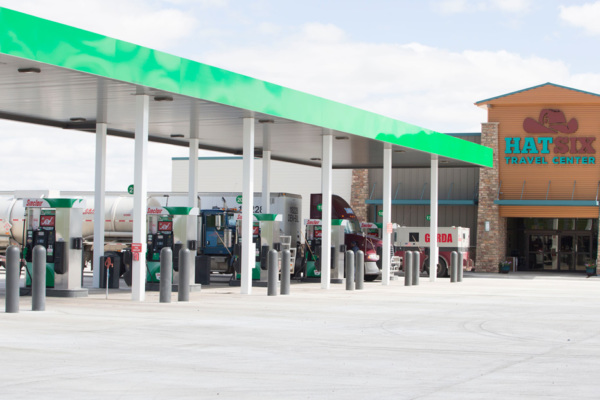E-commerce sales have been increasing steadily for years but surged as COVID-19 forced social distancing and kept people home. Capacity is expected to tighten even more as the peak holiday season approaches, and growth in the trucking center could benefit truckstop and travel plaza operators as they work to serve drivers hauling the nation’s freight.
A Move to E-commerce
“What is very certain is consumer behaviors have shifted, and there has been a permanent change in certain consumer behaviors and certain sectors,” said Balika Sonthalia, a vice president at Kearney, a management consulting firm, and an author of the 31st Annual State of Logistics Report. Sonthalia presented the report during the Council of Supply Chain Management Professionals’ virtual conference in September.
The COVID-19 pandemic grew e-commerce sales to 17 percent of the total U.S. retail market, said Michael Zimmerman, a partner with Kearney and lead author of the 31st Annual State of Logistics Report. “COVID-19 is seen as an accelerator of the transformation to e-commerce,” he explained.
Ryan Kelly, vice president of global e-commerce marketing at FedEx, said COVID-19 accelerated the trends the fleet expected to see over the next couple of years, reinforcing the importance of the strategic initiatives that it already had underway. “That said, we anticipate this will be a record-setting peak for the entire industry,” Kelly said. “We continue to ramp up our resources, maximize our capacity and collaborate with retailers to ensure we’re doing everything possible to prepare for the anticipated peak volumes.”
Tightened Capacity
Kenny Vieth, president of ACT Research, said over-the-road carriers are enjoying a period of volume growth and pricing power that would have been considered shocking, though welcomed, from an April 2020 vantage point.
“The underpinnings for this strength include the lighter impact of COVID-19 on goods-producing sectors, which are truck intensive, as compared to the devastation still being felt by services sectors, which are not trucking intensive,” Vieth said. “In addition, the consumer spending substitution away from experiences and toward goods, pent-up demand for inventory restocking, a hot housing market, low interest rates and low energy prices are supporting freight.”
Vieth added, “The story for the transport sector and particularly for heavy-duty trucks can be summed in two words: surprisingly strong.”
While speaking on Sept. 15, Tim Denoyer, vice president and senior analyst of ACT Research, said truckload capacity has been tight for a few months, and intermodal capacity is tightening as well. As a result, spot rates have surged, and ACT Research forecasted double-digit growth in spot rates for the rest of this year and 2021. With freight demand improving and drivers uniquely short, higher freight rates are a one-way bet at this point, and higher driver pay isn’t far off, he explained.
Zimmerman said carriers have not been able to add capacity fast enough, and those industries that have seen demand increase have been forced onto the spot market as their regular carriers never planned for such surges. “The injured industries have freed up capacity, which has gone to the spot market to keep busy. So, even if we are in a recession and are suffering from overall demand destruction, shippers are willing to pay a premium for the capacity they need at the last minute,” he said.
The strong trucking growth is good news for the truckstop and travel plaza industry that has worked around the clock to keep trucks and goods moving. During an interview with Transport Topics Radio on Sirius XM, NATSO President and CEO Lisa Mullings said fuel volumes dropped as much as 50 percent during the initial COVID disruptions. “By June, things were looking up, and now the latest we've heard is that the volumes are not quite where they were pre-COVID, but they have recovered quite nicely since March,” she said. “I think where our members are suffering a little bit more is on the four-wheeler side.”
Holiday Travel
Truckstops and travel plazas could benefit throughout the holiday season due to constant freight movement and a potential increase in passenger vehicle travel if more people choose to travel by car rather than air.
AAA, which releases seasonal travel forecasts, said it will issue estimates for Thanksgiving and year-end holiday this year. It cancelled its Memorial Day forecast due to uncertainty surrounding COVID-19. Julie Hall, public relations manager for AAA National Office, said the estimates will be issued in November and December, respectively.
A Potentially Strong Holiday Season
According to a recent annual holiday retail forecast by Deloitte, e-commerce sales will grow by 25 percent to 35 percent year-over-year during the 2020-2021 holiday season, compared to 14.7 percent in 2019. “For retailers, this holiday season will continue to push the boundaries on the importance of online, convenience, the role of the store, and the criticalness of safe and speedy fulfillment,” said Rod Sides, vice chairman, Deloitte LLP and U.S. retail and distribution sector leader.
Overall, Deloitte is forecasting a 1 percent to 1.5 percent increase in 2020 holiday sales compared with the same period in 2019. According to the U.S. Census Bureau, retail sales between November 2019 and January 2020 (seasonally adjusted and excluding automotive and gasoline) grew 4.1 percent and totaled nearly $1.14 trillion.
The National Retail Federation’s annual consumer holiday survey found that a majority of shoppers, 59 percent, plan to shift more of their shopping online compared with last year.
While consumer spending has recovered from the coronavirus pandemic more quickly than expected, forecasting 2020 holiday sales is challenging, said Jack Kleinhenz, chief economist for the National Retail Federation. He equated it to assembling a jigsaw puzzle without all the pieces but said he is “cautiously optimistic” about the fourth quarter in terms of the economy and consumer spending. “The recession appears to be behind us, and the re-opening of the economy over the past several months has created momentum that should carry through the fourth quarter,” he said.
The outlook, however, is clouded with uncertainty related to COVID-19 infection rates. Kleinhenz said NRF is waiting for new data and are still assembling puzzle pieces for the 2020 holiday season. “The test is whether consumer spending will be sustained amid wildcard puzzle pieces including policy surprises, the election and a resurgent virus,” he said.
(Read Three Things Truckstops Should Keep in Mind this Holiday Season for more on the holiday season and truckstops.)
Early Holiday Promotions
Many retailers are expected to move holiday promotions up this year. Truckstops and travel plazas may also want to follow suit, moving holiday promotions earlier in the fall.
The National Retail Federation has launched a campaign encouraging people to shop early. “This is going to be a historic holiday season, and while some memorable traditions may change, the tradition of retailers supporting their customers and their communities is stronger than ever. That is why we encourage consumers to adopt two new traditions this year – shop safe and shop early – so we can all celebrate a happy and healthy holiday,” said NRF CEO Matthew Shay. “Retailers are prepared for an early start to the shopping season, offering discounts earlier to ensure consumers can find the gifts they want, in stock at the price they want to pay, delivered at the time they want to receive them.”
NRF's “New Holiday Traditions” campaign will include advertising across digital and social media, radio and TV that will air from October through mid-November in target markets across the country.
Continued Adoption of E-commerce
Those within the industry expect e-commerce to continue to grow at a more rapid pace due to COVID-19, which has permanently exposed the benefits of online retail, said Satish Jindel, founder of SJ Consulting Group. “Brick and mortar retailers will see an acceleration of the decline in sales at the stores, and if they do not get proper help with implementing online sales channels and distribution solutions, they will see their business decline at a faster pace,” he said.
Zimmerman said that overall, e-commerce merchants have been growing five times faster than off-price retailers and 20 times faster than the broader retail market, which will continue to drive structural changes in transportation markets. “They will affect demand, pricing, volatility, and investment requirements,” he said.
While speaking during the Future of Freight and Supply Chain Management virtual summit presented by Transport Topics and CQ Roll Call, Drew Wilkerson, president of North American transportation at XPO Logistics, said its customers, both retail and nonretail, are looking for providers that can flex capacity up and down as the market shifts. “We’ve really been focused on helping some of our brick and mortar customers in the retail sector shift more from omnichannel into the e-commerce growth,” he said.
Subscribe to Updates
NATSO provides a breadth of information created to strengthen travel plazas’ ability to meet the needs of the travelling public in an age of disruption. This includes knowledge filled blog posts, articles and publications. If you would like to receive a digest of blog post and articles directly in your inbox, please provide your name, email and the frequency of the updates you want to receive the email digest.

